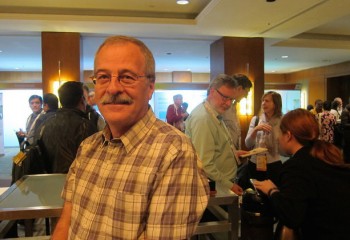
SYDNEY, Australia (CIMMYT) – When storybook character Alice stepped through the looking glass, the Red Queen encouraged her to run as fast as she could. Alice did, but despite her efforts she remained stuck in one place:
“Now, here, you see, it takes all the running you can do, to keep in the same place. If you want to get somewhere else, you must run at least twice as fast as that!” said the Red Queen.
Philip Pardey, a professor in the Department of Applied Economics at the University of Minnesota, referred to the Red Queen character in Lewis Carroll’s 19th century novel “Through the Looking Glass” at the International Wheat Conference in Sydney, Australia to illustrate a conundrum about wheat rust disease research.
Despite efforts to develop wheat that is resistant to damaging stem, stripe and leaf rusts, the diseases, which have existed for 10,000 years, will continue to thwart scientists, Pardey said, adding that the annual global investment in wheat rust research should be $108 million a year in perpetuity.
Currently, major projects such as the Borlaug Global Rust Initiative, which is directed at completely wiping out Ug99 stem rust, are funded for set periods of time and target specific strains of rust. It is unfeasible to expect a cure to be found, Pardey argued.
“It’s fallacious to think that we can ‘solve the stem rust problem’ through funding because the actual solution sows the seeds of its own destruction,” Pardey said, explaining that the fight against rusts is ongoing and must be funded continuously.
RED QUEEN EFFECT
Just as Alice and the Red Queen ran in one spot as hard as they could but got nowhere, rust sexual reproduction and genetic re-combinations fight to survive, allowing wheat rusts to co-evolve and adapt to changes in their environment.
In his study, Pardey determined that global losses from all three rusts average at least 15.04 million tons (552.8 million bushels) per year, equivalent to an average annual loss of about $2.9 billion a year.
He calculated that the economically justifiable investment in wheat rust research and development should be $108 million a year, equivalent to an annual investment of $0.51 per hectare per year across the current 212 million hectares (524 acres) of wheat worldwide.
“The nature of the intervention is that the very seeds of success of wheat breeders sows their own destruction,” Pardey said. “A co-evolutionary pressure is developed where rust has every incentive to survive, so when fungicides are used or the biology of the plants is altered to resist those fungi, it forces evolutionary pressure on the fungi to evolve around that resistance.”
Almost the entire global wheat crop is at risk of infection from wheat rusts, Pardey said. Globally, only 3.2 percent of the crop is grown in areas not susceptible to infection, while 62.7 percent of the crop is in areas that are vulnerable to all three rusts.
“I’m hopeful Pardey’s research findings illustrate the importance of ongoing funding for wheat rust research,” said Hans Braun, head of the Global Wheat Program at the International Maize and Wheat Improvement Center (CIMMYT) and the Wheat Research Program overseen by the CGIAR consortium of agricultural researchers.
“Pardey’s research is critical in highlighting the severity of the threat from all three types of rust, showing that continuous funding in perpetuity is the best way to keep them in check. Consistent funding will make it easier to help farmers and protect food security by controlling the disease.”
GLOBAL RISKS
Through modeling for both seasonal vulnerability and system vulnerability, Pardey determined that losses at any particular location or point in time do not represent the average annual global losses over the longer term.
“In 1935, the United States lost a fifth of the crop to rust, last year they lost less than half a percent,” Pardey said. “So, I wouldn’t want to take last year’s loss as being representative of the losses of this disease, nor would I want to take the 1935 loss. It’s not representative.”
Pardey developed a framework to characterize the probabilistic nature of losses over the century, then conducted a Monte Carlo simulation – which assesses risk impact under all possible outcomes of a given scenario – to determine a loss average estimate.
“If wheat breeders are successful in getting modern varieties onto all the wheat areas around the world, there is additional value because they’re at a higher yield level when the disease pulls the yields down,” Pardey said.
“High-yield varieties make the value of the rust avoidance go up as the yield goes up. You’ve got a virtuous cycle. The rust resistance becomes more valuable the more extensive the higher yielding varieties are spread. An investment of $108 million a year just allows us to keep up with it – we’re running fast to stand still.”
 Innovations
Innovations 
